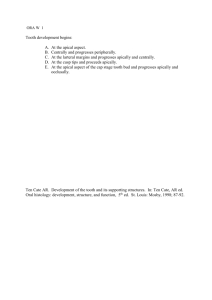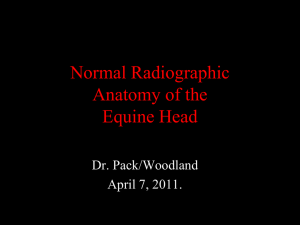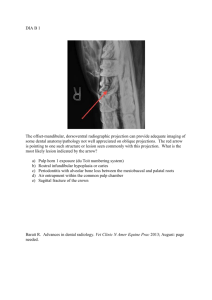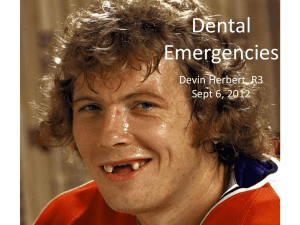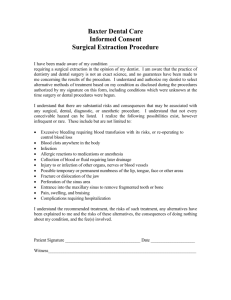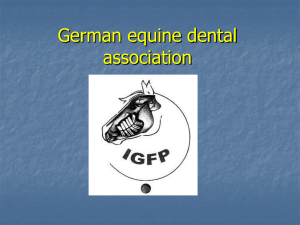Released EVDC Eq Exam Example Questions Oral Surgery 8
advertisement
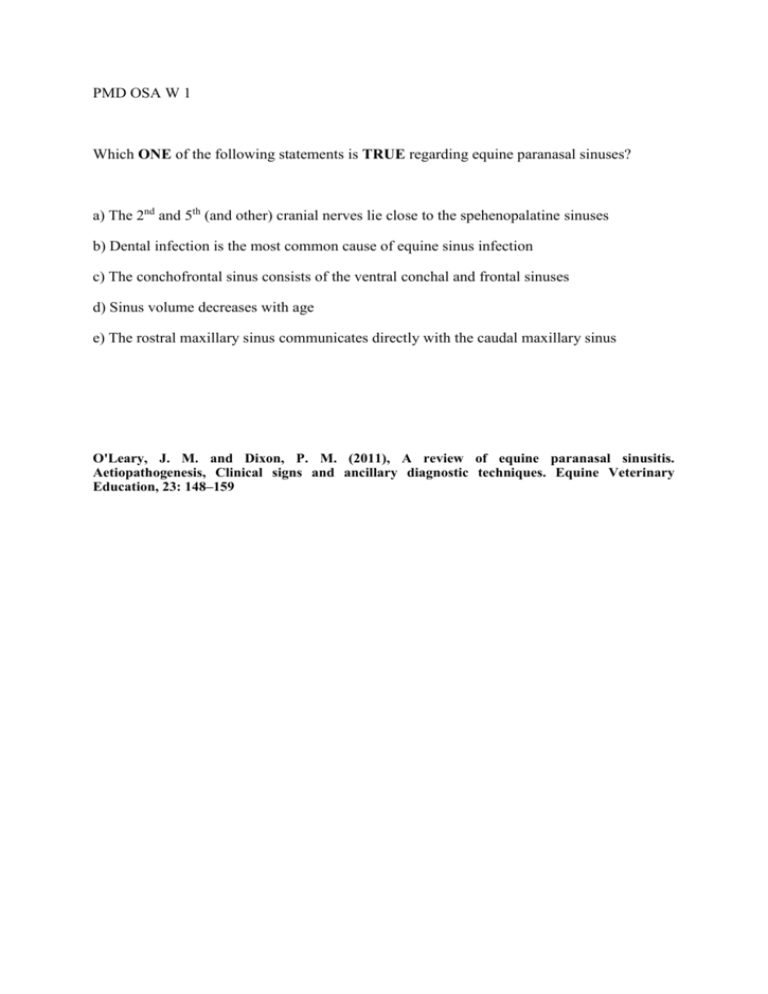
PMD OSA W 1 Which ONE of the following statements is TRUE regarding equine paranasal sinuses? a) The 2nd and 5th (and other) cranial nerves lie close to the spehenopalatine sinuses b) Dental infection is the most common cause of equine sinus infection c) The conchofrontal sinus consists of the ventral conchal and frontal sinuses d) Sinus volume decreases with age e) The rostral maxillary sinus communicates directly with the caudal maxillary sinus O'Leary, J. M. and Dixon, P. M. (2011), A review of equine paranasal sinusitis. Aetiopathogenesis, Clinical signs and ancillary diagnostic techniques. Equine Veterinary Education, 23: 148–159 OSA W 2 Which ONE of the following statements on idiopathic tooth fractures is TRUE? a. The majority of fractures encountered in maxillary cheek teeth runs sagittally through the palatal pulp chambers b. Most mandibular slab fractures are located on the palatal side of the cheek teeth c. Mandibular slab fractures usually involve the full length of the tooth d. Maxillary buccal slab fractures run through pulp chambers 3 and 4 e. Mandibular cheek teeth are more susceptible to develop idiopathic tooth fractures than maxillary cheek teeth Ref Dacre et al (2007) Equine idiopathic cheek teeth fractures. Part 1: pathological studies on 35 fractured cheek teeth. Equine Vet Journal 39; 310-318. OSA W 3 The elastic properties of the equine periodontal ligament have recently been investigated using finite element techniques by Cordes V, Gardemin M, Luepke M, et al. Finite element analysis in 3-D models of equine cheek teeth. Veterinary Journal 2012;193:391-396. These researchers found: A) With age, stress on the ligament and surrounding bone increases, as does the level of intrusion (movement in a vertical direction within the alveolus). B) With age, stress on the ligament and surrounding bone increases, but the level of intrusion (movement in a vertical direction within the alveolus) decreases. C) With age, stress on the ligament increases, but stress on the surrounding bone and the level of intrusion (movement in a vertical direction within the alveolus) decreases. D) With age, stress on the ligament and surrounding bone decreases, as does the level of intrusion (movement in a vertical direction within the alveolus). E) There was no effect of age on the stress on the ligaments and bone, nor on the level of intrusion. Reference: (Above) OSA B 1 What is the most likely common equine oral tumor depicted in the above image? A. B. C. D. E. Squamous cell carcinoma Epulis Basal cell tumor Ameloblastic odontoma Foreign body reaction Knottenbelt, DC and DF Kelly. Oral and dental tumors. Easley J, Dixon PM, and Schumacher J. Equine Dentistry 3rd ed. Philadelphia: Saunders, 2010;149-181. OSA B 2 In this cadaver, a frontal sinus bone flap has been created to access the left conchofrontal sinus. Select the answer that best finishes the following sentence. The arrow points to ____: a. the nasomaxillary aperture, which drains both the rostral and caudal maxillary sinuses. b. the ethmoid concha that is located dorsal to the frontomaxillary opening. c. a sinus cyst originating from the dorsal conchal sinus. d. an ethmoidal hematoma. e. the bulla of the ventral conchal sinus (now termed the bulla of the maxillary septum) which is contiguous with the septum between the rostral and caudal maxillary sinuses. Easley J and Schumacher J. Basic equine orthodontics and maxillofacial surgery. In Easley J, et. al. Equine Denistry, 3rd ed. Edinburgh: Elsevier (2010), 302 OSA B 3 Which option best finishes the sentence? In this dissection of the head, the vascular structures deep to the masseter muscle (40) are the___________. a. b. c. d. e. deep facial artery, vein, and nerve. lingual artery, vein, and nerve. buccal artery, vein, and nerve. deep masseteric artery, vein, and nerve. hypoglossal artery, vein, and nerve. Popesko P. Atlas of Topographical Anatomy of the Domestic Animals. Volume 1, Sixth Ed. Philadelphia: Saunders (1990) 127. OSB W 1 Which ONE of the following exodontia techniques IS MOST LIKELY to have the highest prevalence of complications? a) Extraction of a maxillary cheek tooth per os b) Extraction of a fractured cheek tooth under oroscopic guidance c) Repulsion of a mandibular cheek tooth under general anaesthesia d) Extraction of a mandibular cheek tooth per os e) Extraction of a mandibular cheek tooth via a lateral buccotomy Tremaine, WH Schumacher J (2012) Exodontia. In: Equine Dentistry 3rd Eds Easley J , Dixon PM and Schumacher J Elsevier Dixon PM, Hawkes C and Townsend N. (2008) Complications of oral surgery. Vet Clinics of North Am, 24 499-514, OSB B 1 The pictures above demonstrate what named incisor wiring technique? A. B. C. D. E. The Easley technique The Easley technique The Obwegeser or Stout Multiple Loop technique The Holtz technique The Schmidt technique Auer JA. Craniomaxillofacial Disorders. In: Equine Surgery 3rd edn. Auer JA and Stick JA eds. Saunders Elsevier St. Louis MO. 2006; 1344. Holmstrom, Frost, Eisner. Veterinary Dental Techniques for the Small Animal Practictioner. Philadelphia:Saunders, 1998 (newer edition available), pg471-473. OSB B 2 Following an oral extraction of an apically infected 406, the radiograph reveals remaining distal (caudal) root fragments. Which of the following techniques would be the most appropriate to extract the retained mandibular root fragments? a) b) c) d) e) Oral extraction using fragment forceps Self-extraction by filling the alveolus with medical grade honey Repulsion with a dental punch under general anesthesia Orally using dental elevators (picks) under endoscopic guidance Standing repulsion using a Steinmann pin Ramzan PHL, Dallas RS, Palmer L. Extraction of Fractured Cheek Teeth under Oral Endoscopic Guidance in Standing Horses: 30 cases. Vet Surg 40, 586-9, 2011. OSC W 1 You are presented with a horse that has a history of a retained deciduous premolar that is wedged between the emerging teeth on either side. This impacted tooth has a ventral discharging tract. Your best approach for removal of this tooth is: A. B. C. D. E. Standing repulsion Surgical repulsion Transcortical buccotomy Intraoral extraction Don’t remove place the horse on long term antibiotics for six weeks Reference: Tremaine WH and LK McCluskie. Removal of 11 Incompletely Erupted, Impacted Cheek Teeth in 10 Horses using a Dental Alveolar Transcortical Osteotomy and Buccotomy Approach. Vet Surg 2010:8:884-890. OSC W 2 Which of the following answers summarizes the most frequent serious complications associated with a horizontal or vertical buccotomy approach to dental extraction best? A. Transection of the parotid salivary duct, facial paralysis from trauma to the buccal branches of the facial nerve, wound dehiscence B. Facial paralysis from trauma to the buccal branches of the facial nerve, oromaxillary sinus fistula formation, sequestration of alveolar bone C. Transection of the parotid salivary duct, sequestration of alveolar bone, wound infection and dehiscence D. Facial paralysis from trauma to the buccal branches of the facial nerve, transection of the parotid salivary duct, trauma to adjacent dental structures E. Trauma to adjacent dental structure, oromaxillary fistula formation, wound infection and dehiscence References: Tremaine WH, Schumacher J. Exodontia. In: Easley J, Dixon PM, Schumacher J, eds. Equine Dentistry 3rd ed. Philadelphia: Saunders, 2010;319-344. Lane JG. Equine dental extraction: repulsion vs. lateral buccotomy, techniques and results. In: Proceedings:World Veterinary Dental Congress, Birmingham 1987:135-138. OSC B 1 The image shows acrylic material in an alveolus post-extraction. What is the most likely purpose for the acrylic material? a) b) c) d) e) Prevent mesial drifting of the distal tooth Prevent distal drifting of the mesial tooth Prevent super-eruption of the opposing tooth Prevent impaction of feed material into the alveolus Retain antibiotic gel to aid in the healing process Lowder MQ. Exodontics of Equine Teeth. In: Klugh, DO. Principles of Equine Dentistry. London: Manson Publishing Ltd., 2010; 129-141.

